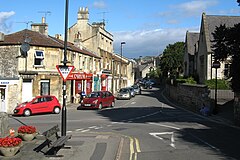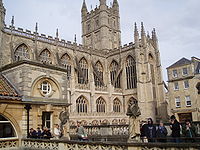Human settlement in England
| Weston | |
|---|---|
 Southern High Street, Weston, 2010 Southern High Street, Weston, 2010 | |
 | |
| Population | 5,237 (ward, 2011) |
| OS grid reference | ST728665 |
| Unitary authority | |
| Ceremonial county | |
| Region | |
| Country | England |
| Sovereign state | United Kingdom |
| Post town | BATH |
| Postcode district | BA1 |
| Dialling code | 01225 |
| Police | Avon and Somerset |
| Fire | Avon |
| Ambulance | South Western |
| UK Parliament | |
| 51°23′49″N 2°23′35″W / 51.397°N 2.393°W / 51.397; -2.393 | |
Weston is a suburb and electoral ward of Bath in Bath and North East Somerset, Somerset, England, located in the northwest of the city. Originally a separate village, Weston has become part of Bath as the city has grown, first through the development of Lower Weston in Victorian times and then by the incorporation of the village into the city, with the siting of much local authority housing there in the period after World War II.
The ward includes Upper Weston, Weston village, Weston Park and the lower slopes of Primrose Hill. The area known as Lower Weston, south of Weston Road, is within Newbridge ward.
History
The earliest evidence of occupation comes from two Celtic caddy spoons found in the village in 1825. There are believed to have been used as ceremonial anointing regalia.
During the 10th century, Weston had been divided into two estates. One, on the slopes of Lansdown was given by Edmund I to Aethelare in 946. Weston was the birthplace of Saint Alphege who was born around 954. Two manors with 41 households are recorded in the Domesday Book of 1086: one held by Bath Abbey and the other by Arnulf de Hesding.
During the 12th and 13th centuries Weston had close ties with the monks of the abbey, and in the late 13th century the first vicar of Weston was appointed by the church. Weston was part of the hundred of Bath Forum, with a manorial court or halmote being held in the parish. The land continued to be owned by the church and leased to tenants until the dissolution of the monasteries in 1539, after which the estates in Weston reverted to the king. In 1628 the land was sold to the Corporation of London although the king continued to receive rent until 1671, when it was sold to Sir Walter Long, Member of Parliament for Bath from 1679 (the Habeas Corpus Parliament) to 1681. Following the Battle of Lansdowne in 1643, some of the defeated Roundheads took refuge in Weston.
The village expanded during the 19th century with many areas being drained, the church rebuilt and new schools established. The Georgian expansion of Bath saw many houses built in Weston, and in 1834 Partis College was built nearby in Newbridge. Developments continued into the Victorian era with Weston Park and Combe Park being developed.
Weston was an ancient parish extending from the River Avon to the Gloucestershire boundary north of Lansdown. It became a civil parish in 1866. The southern parts of the parish were absorbed into Bath in 1911 and 1951, and the remaining, more rural, parts were absorbed into the civil parishes of Charlcombe and Kelston on 1 April 1953. In 1951 the parish had a population of 175.
Parts of Weston are at risk of flooding due to old watercourses, sinks and springs in the area. West Brook now runs underground below the High Street, but floods periodically. In 2013 the Weston Catchment alleviation scheme was announced to further protect the area.
Services
Bath's main hospital, the Royal United Hospital, is just over the ward boundary in Newbridge, on one of the roads from central Bath into Weston.
Weston has two primary schools: Weston All Saints C.E. V.C Primary School, and St Mary's Catholic Primary School. Lower Weston is served by Newbridge School; an earlier primary school called Weston St John's closed when the primary departments at Newbridge expanded in the 1970s.
Weston has many local amenities, including a recreation ground and youth club, and shops and services including a bakery, Spar off-licence, post office, pharmacy, a takeaway, a bike shop and a newsagents. There is also a carpet shop and two hair salons. The village is dominated by a Tesco Express supermarket.
Weston village is home to the 66th Bath Scout Group who meet at the former school on the High Street. In Lower Weston, the 69th Bath Scout Group meet at the Methodist church. Bath Scouts also own a campsite on the edge of Weston at Cleeve Hill. Rainbows, Brownies and Guides also meet within the village, along with a Boys' Brigade Company.
Religious sites

The village parish church is All Saints, founded no later than 1156. The current church dates from 1832 and was designed by the local architect John Pinch the younger, except for the tower which dates from the 15th century. The Lower Weston parish church is St John's, barely a mile from Bath's city centre, and now in Kingsmead ward. There is also a Moravian church sited at the bottom of Lansdown Lane; the nearest Catholic church is St. Mary's on Julian Road.
Transport
Weston is served by four main bus routes, operated by First and The Big Lemon and providing connections towards Lower Weston, Newbridge, Bath City Centre, Twerton, University of Bath, Oldfield Park and Odd Down.
The Weston (Bath) railway station was at Lower Weston and closed in 1953, although the platform building and the stationmaster's house still exist. The station was on the Midland Railway line from Bath to Bristol and to the north, which closed in 1966.

References
- "Weston". UKCrimeStats.com. Retrieved 12 January 2012.
- "Ward Maps". Bath & North East Somerset Council. Archived from the original on 3 April 2011. Retrieved 10 March 2011.
- "Election Maps". Ordnance Survey. Retrieved 17 October 2020.
- Hargood-Ash page 6
- Hargood-Ash pages 9-12
- Knowles pages 28, 241
- Weston in the Domesday Book
- Hargood-Ash pages 19-28
- Collinson page 97
- "Somerset Hundreds". GENUKI. Retrieved 9 September 2011.
- Hargood-Ash page 29
- Hargood-Ash page 39
- Hargood-Ash page 53
- Hargood-Ash page 84
- Hargood-Ash pages 100-110
- Great Britain Historical GIS / University of Portsmouth, Weston CP/AP. Retrieved 17 March 2020.
- "Population statistics Weston AP/CP through time". A Vision of Britain through Time. Retrieved 30 March 2024.
- "2m flood relief project go-ahead in Bath". Bath Chronicle. 8 February 2013. Retrieved 10 February 2013.
- "Weston All Saints C.E. V.C Primary School". BANES. Retrieved 5 July 2008.
- "St Marys Catholic Primary School". BANES. Retrieved 5 July 2008.
- "Weston Recreation Ground, registered charity no. 304672". Charity Commission for England and Wales.
- "66th Bath (Weston Village) Scout Group". Retrieved 12 September 2019.
- "69th Bath (Lower Weston) Scout Group". Retrieved 12 September 2019.
- Historic England. "Countess of Huntingdon's Chapel (Grade II) (1395382)". National Heritage List for England.
- Memorial Plaques at Lady Huntingdon's Chapel, Trafalgar Road, Weston, Bath (PDF) (Report). Bath Record Office. 2016. Retrieved 14 July 2017.
- "All Saints Weston". Images of England. English Heritage. Archived from the original on 11 October 2012. Retrieved 5 July 2008.
- Oakley
Bibliography
- Reverend John Collinson (1791). The History and Antiquities of the County of Somerset. Vol. 1. ISBN 978-1-171-40217-6.
- Hargood-Ash, Joan (2001). Two thousand years in the life of a Somerset village: Weston, Bath. Weston Local History Society. ISBN 0954164202.
- Knowles, David; London, Vera C. M.; Brooke, Christopher N.L. (2001). The Heads of Religious Houses, England and Wales, 940-1216 (Second ed.). Cambridge: Cambridge University Press. ISBN 0-521-80452-3.
- Oakley, Mike (2002). Somerset Railway stations. Wimborne: Dovecote Press. ISBN 978-1-904349-09-9.
External links
- [REDACTED] Media related to Weston, Bath at Wikimedia Commons
